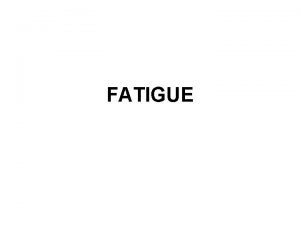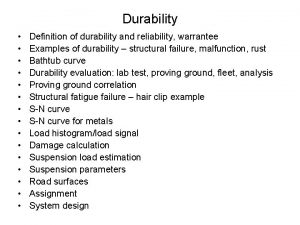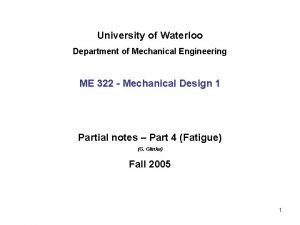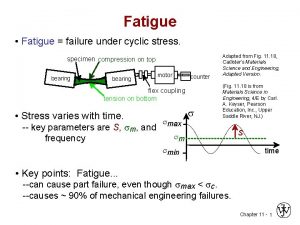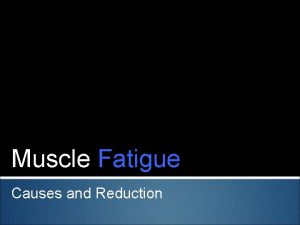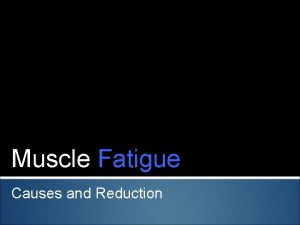FATIGUE Fatigue failure under cyclic stress Adapted from








- Slides: 8

FATIGUE • Fatigue = failure under cyclic stress. Adapted from Fig. 8. 16, Callister 6 e. (Fig. 8. 16 is from Materials Science in Engineering, 4/E by Carl. A. Keyser, Pearson Education, Inc. , Upper Saddle River, NJ. ) • Stress varies with time. --key parameters are S and sm • Key points: Fatigue. . . --can cause part failure, even though smax < sc. --causes ~ 90% of mechanical engineering failures. Chapter 8 - 17

FATIGUE DESIGN PARAMETERS • Fatigue limit, Sfat: --no fatigue if S < Sfat Adapted from Fig. 8. 17(a), Callister 6 e. • Sometimes, the fatigue limit is zero! Adapted from Fig. 8. 17(b), Callister 6 e. Chapter 8 - 18

FATIGUE MECHANISM • Crack grows incrementally typ. 1 to 6 increase in crack length per loading cycle crack origin • Failed rotating shaft --crack grew even though Kmax < Kc --crack grows faster if • Ds increases • crack gets longer • loading freq. increases. Adapted from Fig. 8. 19, Callister 6 e. (Fig. 8. 19 is from D. J. Wulpi, Understanding How Components Fail, American Society for Metals, Materials Park, OH, 1985. ) Chapter 8 - 19

IMPROVING FATIGUE LIFE 1. Impose a compressive surface stress Adapted from Fig. 8. 22, Callister 6 e. (to suppress surface cracks from growing) --Method 1: shot peening 2. Remove stress concentrators. --Method 2: carburizing Adapted from Fig. 8. 23, Callister 6 e. Chapter 8 - 20

CREEP • Occurs at elevated temperature, T > 0. 4 Tmelt • Deformation changes with time. Adapted from Figs. 8. 26 and 8. 27, Callister 6 e. Chapter 8 - 21

SECONDARY CREEP • Most of component life spent here. • Strain rate is constant at a given T, s --strain hardening is balanced by recovery . strain rate material const. • Strain rate increases for larger T, s stress exponent (material parameter) activation energy for creep (material parameter) applied stress Adapted from Fig. 8. 29, Callister 6 e. (Fig. 8. 29 is from Metals Handbook: Properties and Selection: Stainless Steels, Tool Materials, and Special Purpose Metals, Vol. 3, 9 th ed. , D. Benjamin (Senior Ed. ), American Society for Metals, 1980, p. 131. ) Chapter 8 - 22

CREEP FAILURE • Failure: • Estimate rupture time along grain boundaries. S 590 Iron, T = 800 C, s = 20 ksi g. b. cavities Adapted from Fig. 8. 45, Callister 6 e. (Fig. 8. 45 is from F. R. Larson and J. Miller, Trans. ASME, 74, 765 (1952). ) applied stress From V. J. Colangelo and F. A. Heiser, Analysis of Metallurgical Failures (2 nd ed. ), Fig. 4. 32, p. 87, John Wiley and Sons, Inc. , 1987. (Orig. source: Pergamon Press, Inc. ) 24 x 103 K-log hr • Time to rupture, tr temperature function of applied stress time to failure (rupture) 1073 K Ans: tr = 233 hr Chapter 8 - 23

SUMMARY • Engineering materials don't reach theoretical strength. • Flaws produce stress concentrations that cause premature failure. • Sharp corners produce large stress concentrations and premature failure. • Failure type depends on T and stress: -for noncyclic s and T < 0. 4 Tm, failure stress decreases with: increased maximum flaw size, decreased T, increased rate of loading. -for cyclic s: cycles to fail decreases as Ds increases. -for higher T (T > 0. 4 Tm): time to fail decreases as s or T increases. Chapter 8 - 24
